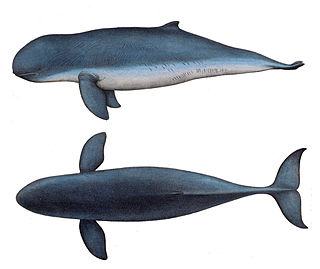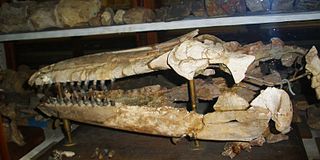
The cetacean family Monodontidae comprises two living whale species, the narwhal and the beluga whale and at least four extinct species, known from the fossil record. Beluga and Narwhal are native to coastal regions and pack ice around the Arctic Ocean. Both species are relatively small whales, 3–5 m (9.8–16.4 ft) in length, with a forehead melon, and a short or absent snout. Premaxillary teeth are absent. They do not have a true dorsal fin, but do have a narrow ridge running along the back, which is much more pronounced in the narwhal. They are highly vocal animals, communicating with a wide range of sounds. Like other whales, they also use echolocation to navigate. Belugas can be found in the far north of the Atlantic and Pacific Oceans; the distribution of narwhals is restricted to the Arctic and Atlantic Oceans.

Orcinus is a genus of Delphinidae, the family of carnivorous marine mammals known as dolphins. It includes the largest delphinid species, Orcinus orca, known as the orca or killer whale. Two extinct species are recognised, Orcinus paleorca and O. citoniensis, describing fossilised remains of the genus. The other extinct species O. meyeri is disputed.

The snubfin dolphins (Orcaella) are a genus of cetaceans containing two members: the Irrawaddy dolphin and the Australian snubfin dolphin. The genus was long believed to be monotypic with the only species being the Irrawaddy dolphin; however, in 2005, supposed Irrawaddy dolphin populations inhabiting the Australian/New Guinean regions were found to be significantly different and were declared a separate new species named the Australian snubfin dolphin.

The rough-toothed dolphin is a species of dolphin that can be found in deep warm and tropical waters around the world.

The Indo-Pacific bottlenose dolphin is a species of bottlenose dolphin. This dolphin grows to 2.6 m (8.5 ft) long, and weighs up to 230 kg (510 lb). It lives in the waters around India, northern Australia, South China, the Red Sea, and the eastern coast of Africa. Its back is dark grey and its belly is lighter grey or nearly white with grey spots.

Humpback dolphins are members of the genus Sousa. These dolphins are characterized by the conspicuous humps and elongated dorsal fins found on the backs of adults of the species. Humpback dolphins inhabit shallow nearshore waters along coastlines across Australia, Africa, and Asia. Their preference for these habitats exposes them to various human activities such as fisheries entanglement, boat traffic, pollution, and habitat loss. Despite these risks, their nearshore presence facilitates easy observation from land.

The Indian Ocean humpback dolphin is a member of the Delphinidae family occupying coastal areas ranging from Southern Africa to Western Indochina. The Indo-Pacific humpback dolphin was formerly included within the same species, but a 2014 study revealed them to be a separate species.

Fraser's dolphin or the Sarawak dolphin is a cetacean in the family Delphinidae found in deep waters in the Pacific Ocean and to a lesser extent in the Indian and Atlantic Oceans.

Lagenorhynchus is a genus of oceanic dolphins in the infraorder Cetacea, presently containing six extant species. However, there is consistent molecular evidence that the genus is polyphyletic and several of the species are likely to be moved to other genera. In addition, the extinct species Lagenorhynchus harmatuki is also classified in this genus.

The northern right whale dolphin is a small, slender species of cetacean found in the cold and temperate waters of the North Pacific Ocean. Lacking a dorsal fin, and appearing superficially porpoise-like, it is one of the two species of right whale dolphin.

The hourglass dolphin is a small dolphin in the family Delphinidae that inhabits offshore Antarctic and sub-Antarctic waters. It is commonly seen from ships crossing the Drake Passage but has a circumpolar distribution.

Peale's dolphin is a small dolphin found in the waters around Tierra del Fuego at the foot of South America. It is also commonly known as the black-chinned dolphin or even Peale's black-chinned dolphin. However, since Rice's work Peale's dolphin has been adopted as the standard common name.

The striped dolphin is a dolphin found in temperate and tropical waters of all the world's oceans. It is a member of the oceanic dolphin family, Delphinidae.

The evolution of cetaceans is thought to have begun in the Indian subcontinent from even-toed ungulates (Artiodactyla) 50 million years ago (mya) and to have proceeded over a period of at least 15 million years. Cetaceans are fully aquatic mammals belonging to the order Artiodactyla and branched off from other artiodactyls around 50 mya. Cetaceans are thought to have evolved during the Eocene, the second epoch of the present-extending Cenozoic Era. Molecular and morphological analyses suggest Cetacea share a relatively recent closest common ancestor with hippopotami and that they are sister groups. Being mammals, they surface to breathe air; they have five finger bones (even-toed) in their fins; they nurse their young; and, despite their fully aquatic life style, they retain many skeletal features from their terrestrial ancestors. Research conducted in the late 1970s in Pakistan revealed several stages in the transition of cetaceans from land to sea.

Australodelphis mirus is an extinct Pliocene dolphin. A. mirus is known from fossils found in the Sørsdal Formation, Mule Peninsula, Vestfold Hills, East Antarctica. The genus has been described as an example of convergent evolution with beaked whales.
The Kattendijk Formation is a five million years old marine geological formation north of Antwerp, Belgium. including the north-western parts of the Campine region. The area was named by De Heuter and Laga in 1976. The sands range from medium fine to coarse and contain a large proportion of shell grit.

Hemisyntrachelus is an extinct genus of cetacean.

Etruridelphis is an extinct genus of cetacean.
Auroracetus, from Aurora and the Latin cetus (whale), is a genus of Pontoporiidae, the river dolphins, and contains one extinct species. The species Auroracetus bakerae was published in 2009.
Eodelphinus is an extinct genus of oceanic dolphins belonging to the family Delphinidae.

















